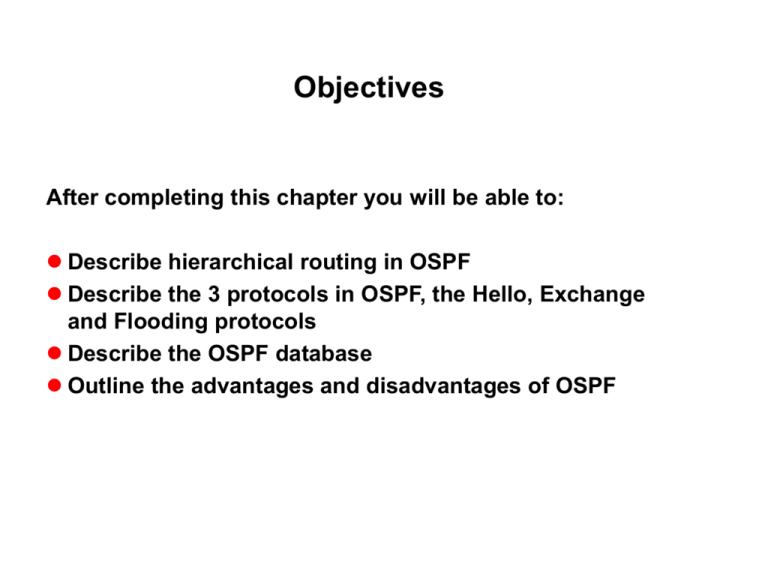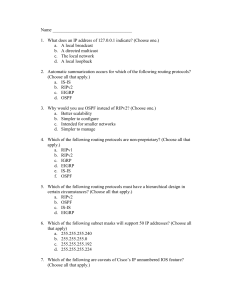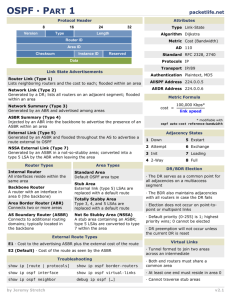Router Links State Record
advertisement

Objectives After completing this chapter you will be able to: Describe hierarchical routing in OSPF Describe the 3 protocols in OSPF, the Hello, Exchange and Flooding protocols Describe the OSPF database Outline the advantages and disadvantages of OSPF Functional Requirements of OSPF A more descriptive routing metric was introduced OSPF can discover multiple best paths to a given destination OSPF supports a 2 level routing hierarchy OSPF supports Variable Length Subnet Masks (VLSM) OSFP packets have a space reserved for authentication OSPF is an example of a link state algorithm that adjusts to network changes quicker than RIP and is more robust Hierarchical Routing Area 2 Area 1 Area 3 Hierarchical OSPF Internetwork Router 1 Router 6 H2 Router 8 Router 2 Router 3 Router 7 Area 1 Area 2 Router 4 Area 0 (Backbone) Router 9 Router 10 Router 11 Router 5 H1 Router 12 Router 13 Area 3 Hierarchical Routing in OSPF Area 0.0.0.2 X W Area 0.0.0.1 Area 0.0.0.3 Area 0.0.0.0 Y Z Hierarchical OSPF Network Example Area 4.0.0.0 External Network LAN 4 Router 4 Router 5 Intra area routing ABR LAN 5 ASBR Multiple copies of algorithm Router 6 Area 0.0.0.0 Inter area routing Router 1 ABR Intra area routing Area 3.0.0.0 Router 3 LAN 3 Router 3 Router 2 Router 2 LAN 2 OSPF Area Types Transit Areas A transit area includes any area capable of propagating or originating Type5 AS external LSAs Stub Areas Stub areas do not import external route information( External LSAs Type 5). Instead, network traffic to destinations not local to the area or AS is directed to the closest area border router advertising a default route Not-so-stubby areas (NSSA) The NSSA (not-so-stubby-area) defines a new OSPF area similar to the stub area in that External LSAs (Type-5) are not propagated into the area nor may they originate in a stub area (via an ASBR). The area may contain an AS border router that may inject NSSA LSAs (Type-7) into the area. OSPF Packet Header Format 24 byte header 0 8 Version(1) 16 Type 24 Message Length Router IP address Area ID Checksum Authentication Type Authentication (octets 0-3) Authentication (octets 4-7) Type 1 2 3 4 5 Meaning Hello Database description Link status request Link status update Link status acknowledgement IP Packet IP protocol 89 31 Sending and Receiving an OSPF Packet Version(1) Type Message Length Router IP address Area ID Checksum Authentication Type Authentication (octets 0-3) Authentication (octets 4-7) Version = 2 Check on IP level Type = 1 (hello) Check IP protocol number (89) Length = entire length OSPF version must be 2 Router IP address = 192.168.10.1 IP address must be on same network as receiving interface Area ID = 3.0.0.0 Checksum = 16 bit checksum of entire packet Authentication = 64 bits Area ID must be = 3.0.0.0 Checksum must be successful Authentication must be successful The Protocols within OSPF Hello protocol -To check that the links are operational. -To elect the Designated Router (DR) and the Backup Designated Router (BDR). Exchange protocol -Performs initial OSPF database synchronisation between two adjacent routers. Flooding protocol -The flooding protocol is used to maintain the two databases in adjacent routers in synchronisation Hello Protocol DR Priority = 1 BDR Priority = 2 HELLO Priority = 7 Priority = 4 Priority = 3 Hello Protocol - OSPF Hello Message Format OSPF Header with Type = 1 Network Mask Dead Timer Hello Int Gway Prio Designated router Backup Designated Router Neighbour(1) IP Address Neighbour(2) IP Address Neighbour(n) IP Address …….. Database Synchronisation 10.1.1.5 10.1.1.7 OSPF Hello OSPF Hello: I heard 10.1.1.5 Database Description: Seq=x Database Description: Seq=x, 5 LSA headers Database Description: Seq=x+1 Database Description: Seq=x+1,1 LSA header Link State Request Packet Link State Update Packet Link State Update Packet Exchange Protocol - OSPF Database Description Message OSPF Header with Type = 2 Must be Zero Database Sequence Number Link Type Link ID Advertising Router Link Sequence Number Link Checksum Link Age …….. IMS The fields starting at Link Type to Link Age are repeated for each link Exchange Protocol & Flooding Protocol OSPF Link Status Request Message Format OSPF Header with Type = 3 Link Type Link ID Advertising Router ……… Exchange Protocol & Flooding Protocol OSPF Link Status Update Message Format OSPF Header with Type = 4 Number of Link Status Advertisements Link Status Advertisement (1) ……………… Link Status Advertisement (n) Exchange Protocol & Flooding Protocol Header Format used for all Link State Advertisements Link Age Link Type Link ID Advertising Router Link Sequence Number Link Checksum Length The OSPF Database - Router Links State Record Number of links --0---EB ---0---Link ID Link Data Type #TOS TOS 0 metric Type #TOS TOS x metric The OSPF Database - The Network Links State Record Network mask Attached router --------Attached router The OSPF Database - The Summary Links State Record Network Mask TOS=0 0 TOS 0 metric ……. …… TOS=x 0 TOS x metric TOS=y 0 TOS y metric ……….. The OSPF Database - The External Links State Record Network Mask E,TOS=0 0 TOS 0 metric External route tag (0) E,TOS =x 0 TOS External route tag (x) x metric Calculation of the Routing Table The present routing table is invalidated. The intra-area routes are calculated by building the shortest path tree into each attached area. The inter-area routes are calculated through the examination of summary LSAs. In ABRs connected to one or more transit areas, the transit area’s summary LSAs are examined to see if better paths exist using transit areas than were found in steps 2 and 3 above. Routes to external destinations are calculated, through the examination of AS external LSAs. Advantages of OSPF OSPF is a standard protocol that all vendors can implement interoperability. It provides rapid, deterministic calculation of internet routes. It uses Link State Advertisements. It facilitate separate administration of differing parts of the internet. It facilitate hiding of detailed information about the internet. It provides a more advanced use of metrics. With OSPF one can isolate misconfigured or malfunctioning routers in the internet and route around them. OSPF provides for the effective use of information derived from other routing protocols Disadvantages of OSPF Link-state protocols use large amounts of router memory to store topological databases, as each router keeps a map of the entire network. When a network experiences frequent changes, link-state routers use a large portion of network bandwidth by sending out LSAs at each network change.








